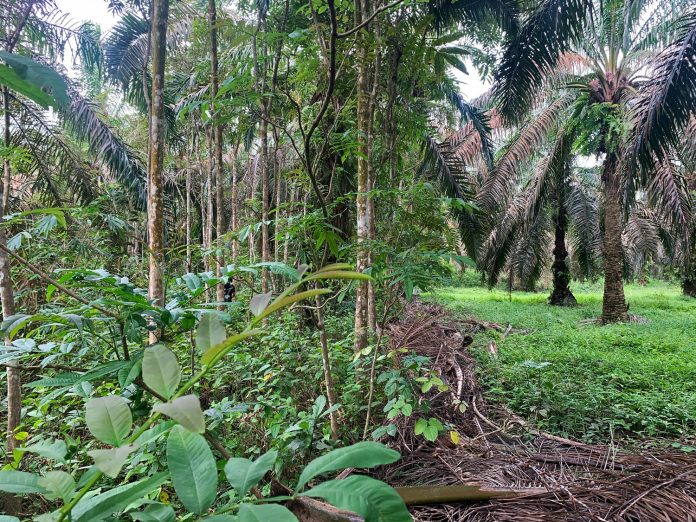- A new study shows that “islands” of trees scattered across oil palm plantations can increase landscape biodiversity while maintaining crop yields.
- Researchers found that within five years of planting these islands of trees, biodiversity and ecosystem functioning improved, with larger areas conferring greater benefits to species such as birds and bats.
- Although these islands can promote biodiversity, the study authors emphasize that they are no substitute for protecting natural forests.
- “For conservation, it is very important to preserve the natural forest and prevent deforestation as a top priority,” said first author Delphine Clara Zemp.
Planting clusters of native trees in oil palm plantations can increase biodiversity without sacrificing yields, according to a new study.
Researchers say the results of an experimental project on the Indonesian island of Sumatra, published in the journal Nature, could be used by industry to provide sanctuary for a range of species.
“By planting these islands of trees, we can see that the diversity of several groups, from soil bacteria to birds and bats, is increasing,” Delphine Clara Zemp, first author of the article and head of the Conservation Biology Lab at the University of Neuchâtel Switzerland, told Mongabay in an interview.
“Islands of trees in the oil palm matrix, representing a harsh environment, could potentially facilitate species movement in this landscape.”
Researchers planted 52 tree islands of varying sizes (ranging from 25 to 1,600 square meters or 270 to 17,200 square feet) in plantations in Sumatra. They found that within five years, biodiversity and ecosystem functioning improved. Larger areas provided greater benefits for species such as birds and bats. Image courtesy of Gustavo Paterno.
The international team, led by researchers from the University of Göttingen in Germany, also found that tree islands improved ecosystem function, affecting water regulation, nutrient cycling and pollination. “We found that there are also significant improvements in our tree islands compared to traditional palm plantations,” Zemp said, adding that the results in terms of tree island size showed that larger areas are better for biodiversity.
Although oil palms have been thinned to make room for other trees within the plantations, this has not resulted in a decrease in yield. That’s because the palm trees around the islands actually increased their yields, Zemp said, and largely offset any losses.
“After only five years of restoration, the results obtained are impressive,” said Benoît Goossens, director of the Danau Girang Field Center in Malaysia, who was not involved in the study, in an email to Mongabay. “The results are of great importance because they show that every forest fragment, every piece of tree cover in an oil palm landscape has its ecological importance and can serve as a stepping stone for many species that use the landscape.”
In addition to supporting biodiversity, the tree islands “could also potentially benefit from the ecosystem services that result directly from better functioning of the ecosystem,” Zemp said.
Although these islands can promote biodiversity, the study authors emphasize that they are no substitute for protecting natural forests. Higher numbers of species were found on the islands, but these were generalist species and less sensitive to human disturbance. “It is very important for conservation to preserve the natural forest and prevent deforestation as a top priority,” Zemp said.
 The biodiversity within the tree islands improved within three to five years. Researchers analyzed soil microorganisms, invertebrates, birds, bats and plants; Larger island areas offered greater benefits. The research is part of a ten-year project of the Collaborative Research Center at the University of Göttingen. Image courtesy of Clara Zemp.
The biodiversity within the tree islands improved within three to five years. Researchers analyzed soil microorganisms, invertebrates, birds, bats and plants; Larger island areas offered greater benefits. The research is part of a ten-year project of the Collaborative Research Center at the University of Göttingen. Image courtesy of Clara Zemp.
Goossens agreed that it was important not to send the “wrong message” that deforestation is acceptable as long as fragments remain in the plantations or regrow.
“The biodiversity that you restore by restoring these areas is not going to reach the level of biodiversity that you had in a natural forest,” he said. But he also said that the palm oil industry should learn from the study and incorporate tree islands into existing plantations: “In fact, I would encourage the industry to conserve/restore as many areas of different sizes as possible.”
Banner image: A green crested lizard on Borneo. Although the study results show a way to promote biodiversity and provide sanctuaries in palm plantations, the researchers emphasize that protecting natural forests is of paramount importance. “Our results indicate that augmenting oil palm landscapes with tree islands is a promising ecological restoration strategy, but should not replace protection of the remaining forests,” they write. Image by Erik via Flickr (CC BY-NC-SA 2.0).
In oil palm-dominated Malaysia, agroforestry plantations are havens for birdlife: study
Citation:
Zemp DC, Guerrero-Ramirez N, Brambach F, Darras K, Grass I, Potapov A, … Kreft H (2023). Tree islands improve biodiversity and functioning in oil palm landscapes. Nature, 618(7964), 316-321. doi:10.1038/s41586-023-06086-5
Agriculture, biodiversity, conservation, deforestation, environment, forestry, forests, palm oil, palm oil and biodiversity, plantations, reforestation, tropical deforestation, tropical forests, wildlife conservation pressure
news.mongabay.com
https://news.mongabay.com/2023/06/tree-islands-boost-diversity-in-oil-palm-plantations-study-finds/















